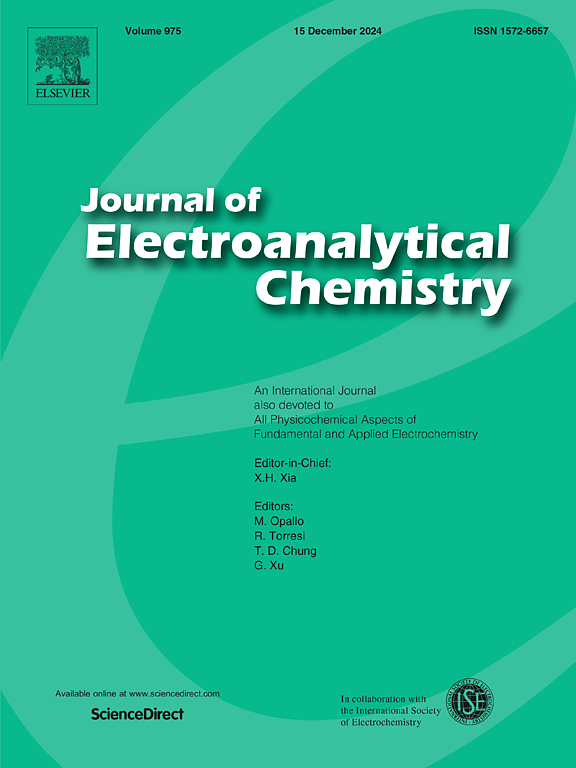在Ti3C2表面装饰球形NiS作为镁硫电池正极材料
IF 4.1
3区 化学
Q1 CHEMISTRY, ANALYTICAL
引用次数: 0
摘要
镁硫电池被认为是锂硫电池非常有前途的替代品,在成本效益和环境可持续性方面具有显着的优势。高性能正极材料的开发对于推进可充电镁硫电池的发展至关重要。在本研究中,我们使用简单的水热法制备Ti3C2@NiS/S复合材料作为正极材料。Ti3C2和NiS的集成不仅提高了复合材料的整体导电性,而且提供了丰富的活性位点,从而获得了优异的放电性能和循环稳定性。与纯NiS/S相比,Ti3C2@NiS/S-2复合材料具有出色的循环耐久性和倍率能力,在0.1C时达到1385 mAh g−1的最大比容量。经过100次循环后,容量保留率保持在72.9%,每个循环的最小容量衰减率约为0.0081%。此外,Ti3C2@NiS/S-2复合材料在0.1、0.2、0.5、1、2和5C的倍率下分别表现出1344、1199.8、1076、904、674和322.5 mAh g−1的可逆容量。当电流密度恢复到0.1C时,可逆比容量迅速恢复到1280.7 mAh g−1。Ti3C2@NiS/S-2优异的放电性能归功于优化后的可逆反应动力学和Ti3C2@NiS/S催化剂结构的稳定性。本文章由计算机程序翻译,如有差异,请以英文原文为准。
Spherical NiS decorated on Ti3C2 as cathode materials in Mg - S batteries
Magnesium‑sulfur batteries are regarded as a highly promising alternative to lithium‑sulfur batteries, offering notable benefits in cost-efficiency and environmental sustainability. The development of high-performance cathode materials is crucial for advancing rechargeable magnesium‑sulfur batteries. In this study, we fabricated Ti3C2@NiS/S composites as cathode materials using a straightforward hydrothermal method. The integration of Ti3C2 and NiS not only enhances the overall conductivity of the composites but also provides abundant active sites, leading to superior discharge performance and cycling stability. Compared to pure NiS/S, the Ti3C2@NiS/S-2 composite demonstrates exceptional cycling durability and rate capability, achieving a maximum specific capacity of 1385 mAh g−1 at 0.1C. After 100 cycles, the capacity retention rate remains at 72.9 %, with a minimal capacity decay rate of approximately 0.0081 % per cycle. Furthermore, the Ti3C2@NiS/S-2 composite exhibits reversible capacities of 1344, 1199.8, 1076, 904, 674, and 322.5 mAh g−1 at rates of 0.1, 0.2, 0.5, 1, 2, and 5C, respectively. When the current density is restored to 0.1C, the reversible specific capacity quickly recovers to 1280.7 mAh g−1. The outstanding discharge performance of Ti3C2@NiS/S-2 is attributed to the optimized reversible reaction kinetics and the structural stability of the Ti3C2@NiS/S catalyst.
求助全文
通过发布文献求助,成功后即可免费获取论文全文。
去求助
来源期刊
CiteScore
7.80
自引率
6.70%
发文量
912
审稿时长
2.4 months
期刊介绍:
The Journal of Electroanalytical Chemistry is the foremost international journal devoted to the interdisciplinary subject of electrochemistry in all its aspects, theoretical as well as applied.
Electrochemistry is a wide ranging area that is in a state of continuous evolution. Rather than compiling a long list of topics covered by the Journal, the editors would like to draw particular attention to the key issues of novelty, topicality and quality. Papers should present new and interesting electrochemical science in a way that is accessible to the reader. The presentation and discussion should be at a level that is consistent with the international status of the Journal. Reports describing the application of well-established techniques to problems that are essentially technical will not be accepted. Similarly, papers that report observations but fail to provide adequate interpretation will be rejected by the Editors. Papers dealing with technical electrochemistry should be submitted to other specialist journals unless the authors can show that their work provides substantially new insights into electrochemical processes.

 求助内容:
求助内容: 应助结果提醒方式:
应助结果提醒方式:


